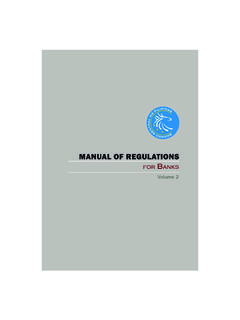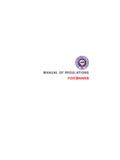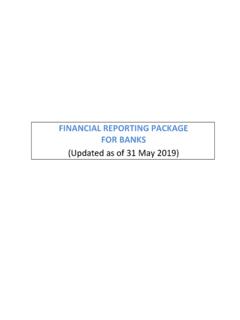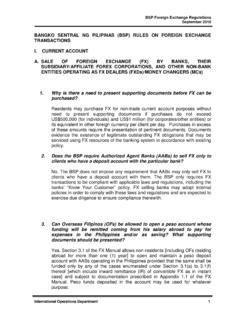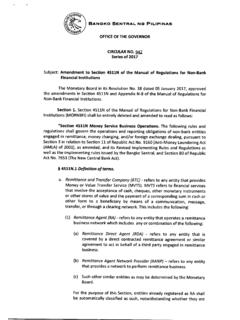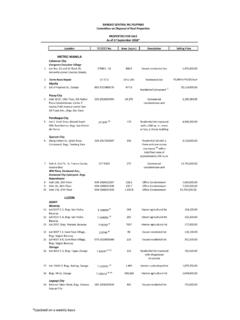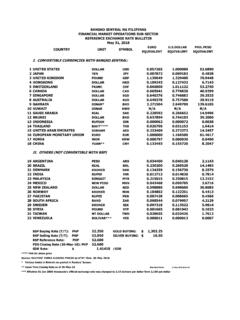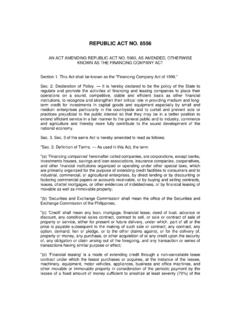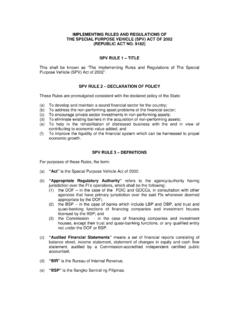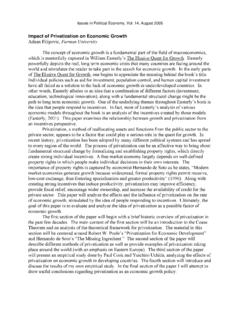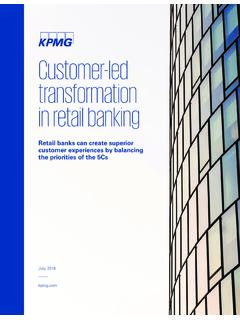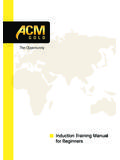Transcription of Contents
1 I Contents Governor s Foreword Who We Are How We Were in 2017: Global and Domestic Macroeconomic Landscape Global Economic Growth Strengthens The Philippine Economy Sustains Solid Growth Box Article 1: Megatrends: Potential Implications for the Philippine Economy Financial Market Conditions Remain Firm Amid Risks Box Article 2: Developing the Philippine Domestic Debt Market Philippine Financial Sector Maintains Solid Performance External Sector Box Article 3: Determinants of Foreign Direct Investments in ASEAN-6 Economies Box Article 4: The Effect of Financial Liberalization in the Balance of Payments What We Did in 2017: Three Pillars of Philippine Central Banking Price Stability: Monetary Policy Stance Remains Supportive of Economic Growth Box Article 5: Evaluating the Forecast Efficiency of Crude oil Futures in Predicting Crude Oil Spot Prices Box Article 6: Behavior and Drivers of Inflation Expectations in the Philippines Box Article 7: Cryptocurrency: Gaining Currency in the Future?
2 Box Article 8: Macroeconomic Analysis of Big Data: Putting Value to Volume, Velocity and Variety Financial Stability: Proactive Supervision Promotes Stability of the Banking System Box Article 9: Raising the Bar on Corporate Governance of Financial Institutions Box Article 10: Streamlining Supervisory Functions Using Innovative Technology Payments and Settlements: PhilPaSS Remains Safe and Efficient Box Article 11: Fintech Developments in the Philippines How We Performed in 2017: Operations, Advocacies, and Financial Results Currency Operations International Reserves Management Box Article 12: Does News on International Reserves Matter to Financial Markets? International Economic Cooperation Advocacy Programs Box Article 13: Results of the 2014 Consumer Finance Survey and Conduct of the 2018 Survey Investor Relations Strengthening Governance Institutional Capacity Building BSP Financial Results Statistical Annexes i Sustaining the Growth Momentum The Philippine economic narrative has been one of robust and resilient growth.
3 With real gross domestic product (GDP) growing by percent in 2017, the Philippine economy has now expanded by more than 6 percent annually over the past five years. At this pace, the country has reaffirmed its standing as one of the fastest-growing economies in Asia. Clearly, the Philippine economy now stands on solid foundations that could support inclusive growth and balanced development. In the coming years, strong fundamentals, built upon the determined pursuit of disciplined macroeconomic management and broad- based governance reforms, will continue to drive improvements in output growth and productivity. For these to translate into palpable improvements in Filipinos quality of living, policymakers will need to sustain the growth momentum.
4 However, an ever-shifting global economic landscape could continue to pose challenges for the conduct of policy, as so-called global megatrends transform the way businesses operate and the way governments tackle policymaking. We have seen some of these forces at work over the past few years including a rebalancing of economic power, a shift in demographics, urbanization, climate change and resource scarcity, and the rise of disruptive technologies, to name a few. The impact of these global trends on market activity and sentiment became even more palpable in 2017. Amid a stronger growth impetus and a broadly stable environment for global commodity prices, central banks in advanced economies found scope to unwind their accommodative policies, fueling volatility in capital flows on expectations of higher interest rates overseas.
5 At the same time, with the shift in growth momentum came some degree of uncertainty, particularly over the direction of macroeconomic agendas across the globe. In particular, rising inequality gave traction to populist sentiment. Indeed, discussions over the possible changes in US trade and immigration policies, the ongoing Brexit negotiations, and mounting geopolitical tensions in the Middle East and Asia reflect the belief that the benefits of growth need to be shared more equally and equitably. Meanwhile, the boom in virtual currencies has prompted discussions on how technology can shape finance and investment, and if policymakers have the tools in place to address new threats arising from technological advances. These developments underscore the need for policies to nurture domestic sources of resilience in sustaining the growth momentum.
6 Decades of reform have resulted in the more disciplined management of the country s fiscal affairs, strengthening the role of fiscal Governor s Foreword NESTOR A. ESPENILLA, JR. Governor ii policy in promoting growth by supporting business confidence and spurring investments. In 2017, the National Government (NG) fueled the momentum by executing the first phase of a series of tax reform packages to help finance its infrastructure development program. Designed to take effect in 2018, these tax reform measures should provide more elbow room to boost public spending on much-needed infrastructure and on targeted social services while keeping the country s debt at manageable levels. Together with various initiatives to improve the ease of doing business in the country and to lift restrictions on foreign ownership for certain industries, these measures should enable the country to attract investments and springboard to more rapid and sustainable growth in the long run.
7 For its part, the Bangko Sentral ng Pilipinas (BSP) recognized how the conduct of monetary policy and financial market supervision needed to adapt to evolving domestic and global economic dynamics in its pursuit of a better quality of life for all Filipinos. As the country s sole monetary authority, the BSP contributed to sustaining the growth momentum in four fundamental areas: (1) Monetary Policy. After falling below target in 2015 and 2016, inflation trended higher in 2017 due mainly to supply-side factors. Consequently, average headline inflation rose to percent, well within the inflation target range of 2-4 percent for the year. Based on its assessment of a manageable inflation environment, supported by firm prospects for domestic economic activity and well-anchored inflation expectations, the Monetary Board decided to hold the BSP s monetary policy settings steady during the year.
8 The BSP continues to be watchful over developments that could pose a risk to the inflation outlook, including further increases in international oil prices and the potential transitory impact of tax reform measures on inflation, in order to maintain price stability. At the same time, the BSP also made significant progress in its shift toward a more market-based implementation of monetary policy. Further refinements to the interest rate corridor framework allowed the BSP s monetary operations to have stronger traction on market interest rates. These improvements will continue to provide the BSP some scope to reduce over the medium term its reliance on reserve requirements for managing liquidity in the financial system, which would help reduce intermediation cost and free up resources to finance productive endeavors.
9 (2) Financial Stability. The Philippine banking system saw double-digit growth in assets, deposits, and capital, backed by sufficient provisioning and adequate capital and liquidity buffers to protect the system against external shocks and uncertainties. Moreover, the BSP pursued proactive reforms to preserve the stability of the financial system amid the emergence of risks arising from rapid technological advances and increasing interconnectivity with the rest of the world. These included, among others, the following initiatives: (i) realigning governance standards and risk management regulations for supervised institutions with international best practices and standards to enhance transparency in the financial system; (ii) leveraging technology to fortify the defenses of the banking system against various cyber-security risks; and (iii) issuing relevant guidelines on virtual currencies to support financial innovations while ensuring consumer protection.
10 The BSP also stepped up its efforts to accelerate the development of the capital market in the country, which will enhance the role of the financial sector as a catalyst for inclusive economic growth. Together with other regulatory agencies, the BSP announced in August iii 2017 a suite of initiatives that would hasten the development of the local currency debt market. These initiatives include the Government Securities Repo Program, which was formally launched in November 2017. (3) Payments and Settlements. The BSP continued to champion the development of the country s backbone for payments and settlements with important milestones in 2017. One is the establishment in June 2017 of an industry-driven, self-governing body the Payments Market Practice Group (PMPG) to drive the responsible development and operations of the country s retail payment system.
